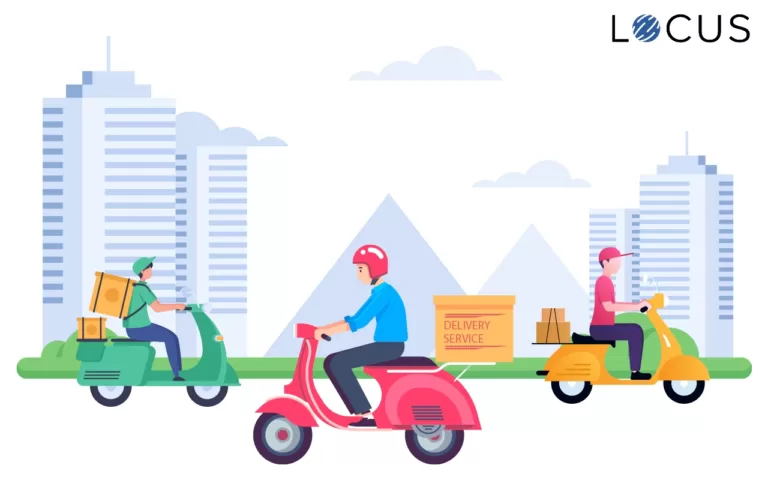Featured
Locus On The Ground April Report: The Ripple Effects of Lockdown
May 8, 2020
6 mins read

With countries across the world in various stages of lockdown, business sectors have been affected in different ways. While traditional FMCG is doing relatively well, other sectors have taken a hit. For this month’s Locus On The Ground April Report, we are focusing on the South & Southeast Asia markets. Locus, which has clients in industries like E-grocery, E-commerce, 3PL, Retail, Pharma, and FMCG, among others, has collated a mammoth 102 million orders, to arrive at these trends.
Note: For the purpose of maintaining client confidentiality, all the graphs below have been normalized.
How to read the graphs: The Y-Axis has been edited to a 0-10 scale. For example, in E-grocery, the non-normalized axis could have been, 0 to 10 million, which has now been normalized to 0 to 10 (Hence each data point represents one-millionth of the original value).
* These graphs are mere representations of trends we have seen on the ground, not actual data points
E-Grocery

Trends we’ve seen across the established grocery companies:
- There has been a drop of 9.8% in April as the pandemic was at its peak.
- There is certainly increasing demand, but reduced on ground labour force and supply-side complexities have resulted in the sector seeing a drop in executed order volumes.
- A small contributing factor could be the fact that a lot of consumers resorted to panic buying in the last couple of months, but there has been a growing realization since then that grocery needs can be met without having to panic buy.
Upcoming grocery players

*Niche grocery players/small players who are beginning to establish their online presence
- These smaller/newer players have seen a growth of 13.1% as compared to March.
- The new entrants and the smaller players are seeing increased traction, because the bigger players are not able to cater to the increasing grocery demands. The reasons for their relative success are simpler supply chain models and lower SKUs. These companies usually cater to niche products.
- Most of the new entrants have a better control over their supply chains, which means reduced dependencies and hence better customer satisfaction.
Expert Opinion
- E-grocery will continue to see a rise, ordering online will become a reality. The supply side constraints have considerably eased up and companies have now adjusted to the new normal, thereby ensuring a better delivery experience.
- The E-grocery space has started to grab more eyeballs and has seen new businesses entering this market. (Eg. Zomato (India), Subway (US), UberEats (globally)).
- There will be an increase in subscription service-based business models.
FMCG
Traditional FMCG

- The FMCG industry has seen a relatively stable performance, it has just seen a small 1.7% drop as compared to March.
- The Covid-19 situation has made the availability of essentials all the more important. This means that FMCG companies will have a steady rate of growth even in these trying times.
- Lack of clarity on the regulations in the early part of the month contributed to a small slump in order volume
B2B E-commerce Distribution (FMCG)

*New-age companies that power FMCG distribution via e-commerce
- This sector has seen a 19% drop as compared to the last month. FMCG brands want to distribute via captive channels for higher margins, thereby resulting in a drop for these new-age distribution channels.
- This sector initially saw a slump due to labor issues, but is now beginning to stabilize.
- Since the nature of the business has a lot of external dependencies, these new-age players could not match expectations.
Expert Opinion:
- These B2B distribution companies will start to stabilize by reducing dependency on larger FMCG brands.
- There will be an emergence of private labels & home brands.
- Large FMCG brands will increase focus to go digital via the E-commerce route.
- Growth in the second half of the year is expected to be better than the first, with an increased focus on health, hygiene, & food products.
Retail

*An overall view of the retail sector, which includes all associated industries
- This sector has seen a 55% drop as compared to March. The regulatory restrictions across Southeast and South Asia are the major reason for the drop.
- The demand for essentials has helped this sector record some sales numbers.
Essential Retail

* Essential Retail are the modern trade retail outlets which have a major focus on grocery.
- Modern trade retail outlets that supply groceries have seen a jump of 74%. Customers are increasingly depending on these stores to get their supplies instead of waiting for E-grocers to deliver.
Expert Opinion
- Brand loyalty will decrease & consumers will prefer cheaper private labels.
- Speed and agility in the retail supply chain will be the key differentiator. Inventory management and delivery experience will have to be addressed by the essential retail sector to keep up the momentum.
Pharma & Diagnostics

- The sector has seen a 40.5% drop in April.
- The demand for non-chronic medications has dipped, thereby resulting in lesser sales.
- End consumers are now frequenting local mom & pop medical shops for their immediate medical needs since there is a lack of visibility on delivery timelines from E-sellers. Many E-pharma companies are functioning with reduced on-ground staff, which makes it tough to deliver on time.
- There is also a lack of clarity on regulations in some countries.
- Lack of ancillary services & goods have also contributed to the slump we see in this industry segment.
- Some of the biggest pharma manufacturers have also seen a 20-25 % drop in sales.
Expert Opinion
- The Supply-side, manufacturing & regulatory environment will drive the major movement in this sector.
- Alternating models of distribution will emerge in these testing times.
E-commerce + 3PL

*E-commerce and associated 3PL players. E-commerce here does not include sales of essential goods
- E-commerce and 3PL deliveries in Southeast Asia and South Asia have dropped very significantly (91.07%) due to the regulations being enforced. Most countries are only allowing delivery of essentials and hence non-essential deliveries have fallen steeply.
Expert Opinion
- Reduced discretionary spending will suppress the potential growth in this sector even after the regulations ease up.
Summary
The lockdown is opening up in different ways across the world but there are a lot of unknowns that will bring volatility in numbers across industries and regions.
Supply Chain and Logistics management is going to be the key differentiator between companies. How quickly companies adapt to the changing scenario will determine their success.

Check out the other month reports:
Related Tags:

Healthcare / Pharmaceutical
Managing the Pharma Supply Chain smoothly amidst the COVID-19 chaos
We’re in the year of a devastating global pandemic that has put the entire mankind at risk. The COVID-19 outbreak has affected over 3.5 million people so far and is continuing to disrupt normal life and economies around the world. Over 100 vaccines are currently under pre-clinical tests, but healthcare experts are still not sure […]
Read more
Delivery Experience
Grocery is now everybody’s best friend
US- Subway, Moe’s Southwest Grill, Panera Bread India- Zomato, Swiggy The UK- UberEats, Deliveroo Ride hailing companies Uber, Lyft. What connects these varied companies? Quite the zinger of a question, eh? While some of them have a food business connection, a few others are from completely different sectors. Well, don’t fret too much. The answer […]
Read moreMOST POPULAR
EDITOR’S PICKS
SUBSCRIBE TO OUR NEWSLETTER
Stay up to date with the latest marketing, sales, and service tips and news


Locus On The Ground April Report: The Ripple Effects of Lockdown